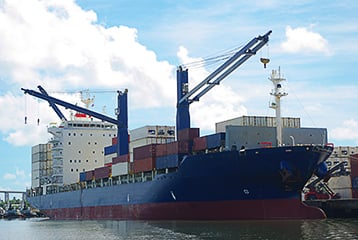New safety requirements for onboard lifting appliances from 1 January 2026
The IMO has adopted SOLAS Regulation II-1/3-13, introducing mandatory safety requirements for on-board lifting appliances. The regulation enters into force on 1 January 2026. This news provides recommendations on how to plan for the new lifting appliances regulations.
Relevant for design offices, shipyards, suppliers and owners/managers.
Summary of new regulations for lifting appliances
New IMO requirements for lifting appliances will apply for vessels with a safety construction certificate (CCC, CSSC or PSSC). To comply, cranes, moveable decks, and ramps lifted with cargo, as well as other lifting appliances, must meet the following criteria:
- Be designed, constructed and installed/certified according to the rules of the vessel’s class society or equivalent standards (non-certified appliances installed prior to 1 January 2026 may alternatively be covered by a “Factual statement”)
- Undergo annual thorough examination and load testing every 5 years. Occasional load test and/or examination shall be performed when deemed necessary, e.g. to verify a repair
- Be subject to regular maintenance and inspection
Note: Flag administrations may have exempted lifting appliances with an SWL below 1 tonne.
These requirements apply upon delivery of a newbuilding, upon installation of new lifting appliances or latest upon first renewal survey after 1 January 2026.
DNV has prepared a new IMO survey and certification service to facilitate compliance with these requirements.
Newbuildings delivered after 1 January 2026
Upon delivery of the newbuilding, lifting appliances delivered/installed as of 1 January 2026 shall follow the new IMO requirements independent of the date of the contract. An IMO electronic cargo gear book shall be issued, stating compliance as described above.
DNV will not be able to issue a safety construction certificate for newbuildings delivered after 1 January 2026 unless the above has been part of the scope and is confirmed for the applicable lifting appliances.
For newbuildings where the keel is laid and the lifting appliance is delivered before 1 January 2026, the principle outlined above will also apply to lifting appliances certified by DNV under the current ILO or non-ILO scheme, provided they have both design approval and product certification.
Retrofit of new lifting appliances after 1 January 2026
Any lifting appliances installed on or after 1 January 2026 will require compliance with the new rules and may trigger implementation of the IMO cargo gear book for the vessel.
DNV will not be able to issue or endorse a safety construction certificate if a retrofit has been fitted without the required certification.
Periodical surveys for existing fleet
For a fleet in service, the transition to the new regime will normally apply upon the first class renewal survey completed on or after 1 January 2026.
The periodical surveys and tests are similar to what is required for ILO152, or the cargo gear book, today, but the scope has now been extended beyond the application for ILO152, which is limited to lifting appliances and ramps handling cargo. Provision cranes, engine room cranes and other lifting appliances or moveable decks and ramps lifted with cargo will need to be included in the cargo gear book. Note: Lifeboat davits, life raft and rescue boat launching appliances are excluded, unless they have a dual purpose, e.g. as a provision crane.
DNVs new electronic IMO cargo gear book states compliance with both the IMO and ILO152 requirements and will be listed as a “certificate” in the Fleet Status on Veracity (for customers only), like the current cargo gear book. The surveys required for the implementation of the new DNV IMO scheme will be visible under Survey Status, upon opening the upcoming main class renewal survey window. The current ILO152 cargo gear book will be kept in the Fleet Status overview until it is replaced by the new, combined IMO cargo gear book.
For most customers, the required data for applicable lifting appliances is already available in DNV’s class production system in the current ILO/OLA survey schemes, and the new IMO survey scheme will be integrated into your vessel’s status as described above. If we suspect that information regarding lifting appliances is missing from our database under the current ILO/OLA scheme, we will issue a retroactive requirement (RR) requesting that owners submit the relevant details via DATE for any SOLAS-relevant lifting appliances for the affected vessels.
Harmonized surveys
Certificates issued after load testing and thorough examinations confirm compliance with SOLAS Regulation II-1/3-13. To maintain harmonization after implementation, we have aligned the new IMO survey requirements with class surveys. As a result, lifting appliance surveys will be scheduled accordingly and, by default, included in survey requests for main class annual and renewal surveys. This approach minimizes the number of vessel visits and aligns activities with docking schedules, enabling more efficient load testing and timely repairs.
Please note that SOLAS Regulation II-1/3-13 also includes requirements for anchor handling winches which typically apply to offshore service vessels and anchor handling tugs used to install, arrange, shift and remove anchors of offshore vessels/units and subsea installations. A separate news will be published on this topic.
Recommendations
- Track progress and review your vessels in the Compliance Planner available in your Fleet Status portal.
- Report SOLAS-relevant lifting appliances and movable decks or ramps lifted with cargo, missing in the current DNV ILO/OLA scheme, via DATE for addition to the new DNV IMO scheme.
- Order SOLAS-relevant lifting appliances and movable decks or ramps lifted with cargo, to be installed on board as of 1 January 2026, with design approval and a product certificate from the vessel’s class society and with a SOLAS-conform rigging plan.
- Prepare for the first renewal survey after 1 January 2026. The required surveys and affected lifting appliances will be made available in the Fleet Status portal and accessible via the main class renewal survey window.
References
Contact
- For customers:
DATE - Direct Access to Technical Experts via My Services on Veracity. - Otherwise:
Use our office locator to find the nearest DNV office.

